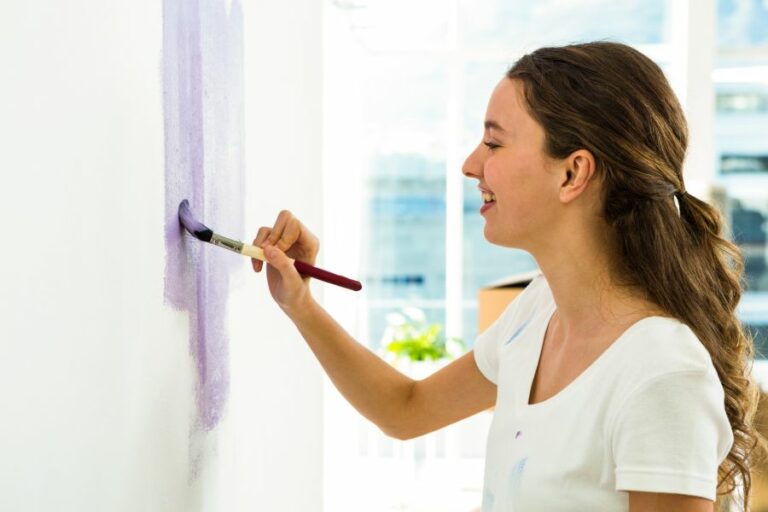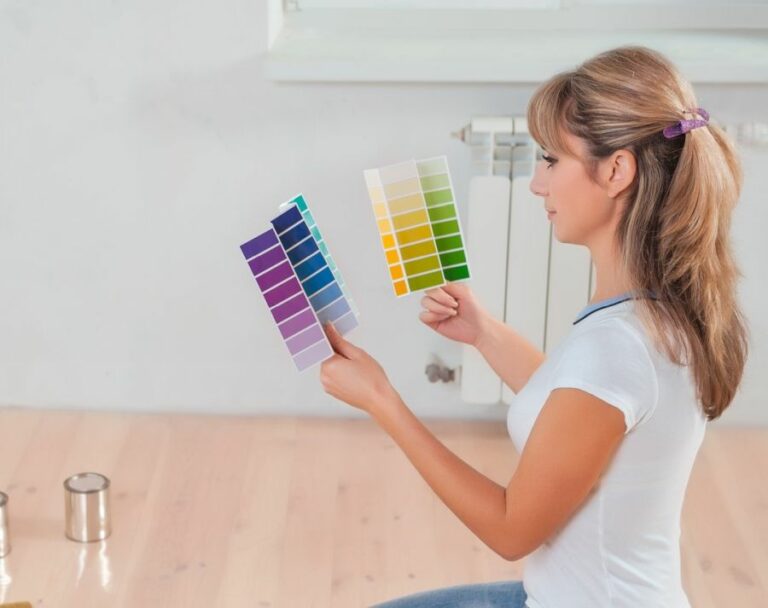Easy Beginner Tips For Indoor Painting
Are you ready to give your walls a fresh makeover but feeling overwhelmed by the thought of painting them yourself? Don’t worry. I have the right beginner tips to help you master indoor painting easily and confidently. With my guidance, you can transform your space like a professional in no time – let’s get started!
Easy beginner tips for indoor painting:>
Choose latex-based paint and a color that complements your decor for easy indoor painting. Gather necessary tools like rollers, brushes, tape, and drop cloths. Prepare the room by removing furniture, covering floors, and prepping surfaces. Use proper painting techniques like rolling in a W or M shape and cutting in edges with an angled brush. Maintain a wet edge, work one wall at a time, and allow for drying before applying additional coats. Clean up tools after use.

Ready to transform your space with a fresh coat of paint? My easy beginner tips for indoor painting are just what you need! Learn how to achieve a flawless finish, even if you’ve never picked up a paintbrush before. Keep reading to become your own interior painting pro!
Contents
- 1 Simple Indoor Painting Guide for Beginners
- 2 Simplifying the Indoor Painting Process
- 3 Proper Sequence for Room Painting Success
- 4 Essential Pre-Painting Preparations to Follow
- 4.1 • Choose the Right Paint
- 4.2 • Gather Necessary Tools and Materials
- 4.3 • Clean and Assess the Surface
- 4.4 • Repair Surface Imperfections
- 4.5 • Remove or Protect Hardware and Fixtures
- 4.6 • Sand and Prime Surfaces
- 4.7 • Protect Floors and Furniture
- 4.8 • Apply Painter’s Tape
- 4.9 • Plan Your Painting Strategy
- 4.10 • Ensure Adequate Ventilation
- 5 Mastering the Art of Painting for Newbies
Simple Indoor Painting Guide for Beginners
• Choose the Right Paint Type and Color
Selecting the appropriate paint type is crucial when painting indoors. There are two main types of paint: latex-based and oil-based.
Latex-based paint is easy to clean, water-soluble, and dries quickly. In contrast, oil-based paint has a longer drying time and requires paint thinner for cleanup. For most indoor painting projects, latex-based paint is recommended due to its ease of use.
Color selection is an essential aspect of indoor painting. Choose a color that complements your furniture, artwork, and overall decor. Test out small paint samples on your wall before committing to a final color.
Visit paint manufacturer websites or a specialized site like ColorPicker to explore different color schemes.
• Gather Necessary Tools and Equipment
Before starting your indoor painting project, gather the following tools and equipment:
- Paint
- Paint roller and roller covers
- Paint tray
- Paintbrushes (angled and standard)
- Painter’s tape
- Drop cloths or plastic sheeting
- Ladder
- Screwdriver (to remove outlet covers or light switch plates)
- Clean cloth
• Prepare the Room and Surfaces
A successful indoor painting job requires proper preparation. Here are useful tips on how to prepare your room:
– Clear the Space
Remove all furniture and decorations from the room. If you can’t remove some heavy items, place them in the middle of the room and cover them with a drop cloth.
– Protect Floors and Fixtures
Cover your floors with drop cloths or plastic sheeting to prevent paint from staining them. Apply painter’s tape to baseboards, window sills, and trim to ensure crisp lines.
– Clean and Repair Surfaces
Dust and dirt can affect the paint’s adhesion, so make sure to wipe the surfaces with a clean cloth. Repair any holes or cracks in the walls with spackling paste or drywall compound. After the repairs have dried, sand the areas to create a smooth surface.
– Prime the Surfaces
Priming is necessary if you are painting over a darker color or a new drywall. It helps hide the previous color, enhances paint adhesion, and provides an even base to apply the paint.
• Painting Techniques: Rolling and Cutting In
Now that your room is prepped, you can start painting. Use these techniques to ensure a professional-looking result:
– Load Your Roller
Dip a paint roller into the paint tray and roll it back and forth to cover the roller evenly. Make sure you don’t overload the roller with paint to avoid drips and achieve even coverage.
– Roll the Paint Onto the Wall
Begin in the middle of the wall, applying a W or M shape with your roller, then roll up and down to fill the spaces within the shape. Keep the roller in contact with the wall as you move to create a smooth finish.
– Cutting In
Cutting in is the process of painting the edges of a wall where a roller can’t reach or cutting in between two different colors. Use an angled paintbrush to apply paint along the edges, such as near the ceiling, around trim, or along baseboards.
Be sure to hold the brush gently and maintain a steady hand to achieve a sharp line.
• Additional Tips for a Stellar Indoor Painting Job
– Maintain a Wet Edge
When working on a wall, it’s crucial to maintain a wet edge to avoid overlapping and unwanted marks. Move systematically from one end to another, keeping the edge wet as you move horizontally along the wall.
– Finish One Wall at a Time
Focus on painting one wall before moving to the next. This ensures even coverage and prevents the paint from drying before you can blend it with the adjacent wall.
– Allow Adequate Drying Time
Always make sure the first layer of paint is completely dry before applying a second coat. This drying time varies depending on the type of paint and the room’s temperature and humidity.
– Clean Up Properly
Cleaning is essential for maintaining the quality of your tools and making them last longer. Remove the roller cover from the roller frame and wash it properly in soapy water. Clean your brushes by gently massaging the bristles to remove paint residue and reshape them before drying.
With these easy beginner tips, you can confidently undertake an indoor painting project and achieve professional-looking results. Happy painting!
Simplifying the Indoor Painting Process
Painting the interior of your home can be an overwhelming task, especially for beginners. Nevertheless, with the proper guidance and knowledge, it can become an easier and more enjoyable experience. Follow these expert tips to make your indoor painting project more manageable and efficient.
• Preparation is Key
Preparing your surfaces and workspace is crucial to ensure a smooth and clean painting process. This step involves:
– Cleaning the Walls
Use a sponge, mild soapy water, and a cloth to clean the walls carefully. This will remove any dirt, grease, or dust that may have accumulated over time. Allow the walls to dry completely before proceeding.
– Repairing Damaged Areas
Examine your walls for any cracks, holes, or dents. Repair these issues with a patching paste or compound, then sand the repaired areas for a smooth finish. Remember to prime any patches before painting.
– Protecting Your Furniture and Flooring
Cover your furniture with drop cloths, old sheets, or plastic to prevent paint spills. Also, use painter’s tape to mask off baseboards, door frames, and window sills, ensuring clean lines and avoiding any paint mishaps.
• Choosing the Right Tools and Paint
Selecting the appropriate tools and paint for your project is essential to achieve a professional and long-lasting finish.
– Picking the Best Paint
Opt for high-quality paint as it offers better coverage, saves time, and leaves a desirable finish. Consider using paint with built-in primer for better adhesion and reduced preparation time. Consult with a professional at a paint store to help you select the correct sheen and color for your space.
– Selecting the Ideal Brushes and Rollers
Invest in quality brushes and rollers for a smooth application and a better finish. Opt for nylon or polyester brushes for water-based paints and natural bristle brushes for oil-based paints.
Choose roller covers with the right nap length for your wall’s texture, shorter naps for smooth surfaces, and longer naps for rough surfaces.
• Efficient Painting Techniques
Using the correct painting techniques is essential to achieve a consistent look and to save time.
– Painting in the Right Order
Paint from the ceiling down to the baseboards, working in sections. Start by cutting in the edges with a brush, then roll the paint onto the main surface, overlapping and blending the brushed areas. This order helps to prevent uneven textures and ensures clean lines.
– Using the “W” Technique
When rolling paint, use the “W” technique for an even distribution of paint. Start by making a “W” shape on the wall, then, without lifting the roller, fill in the gaps with horizontal and vertical strokes. This method ensures a smooth and consistent finish without noticeable roller marks.
– Avoiding Lap Marks
To minimize lap marks, ensure that the leading edge of the paint is kept wet. Roll the full height of the wall and maintain a wet edge so that each stroke of your roller overlaps the previous one before the paint starts to dry.
– Properly Loading Your Brush and Roller
Dip your brush only a third of the way into the paint, then tap the brush against the side of the container to get rid of excess paint. For rollers, submerge the roller in the paint, then roll it back and forth on the tray to evenly distribute the paint.
• Cleanup and Maintenance
Taking care of your tools and workspace will prolong their life and ensure that they are ready for future projects.
– Cleaning Your Brushes and Rollers
Clean your brushes and rollers thoroughly with the appropriate solvent (water for water-based paints and mineral spirits for oil-based paints). Use a brush comb to remove excess paint from the bristles and extend the brush’s lifespan.
– Storing Leftover Paint
Transfer any remaining paint into airtight containers or reseal the original can tightly. Label the containers with the room, date, and paint brand for future touch-ups or reference.
– Maintaining Your Workspace
Safely dispose of used paint cans, solvents, and rags according to your local hazardous waste regulations. Visit EPA’s website for specific guidelines and information.
By following these expert recommendations and implementing these techniques, you can make your indoor painting project easier, more efficient, and more enjoyable. Embrace the process and transform your living space into a beautifully updated and personal sanctuary.
Proper Sequence for Room Painting Success
Painting a room can be an enjoyable and satisfying home improvement project. However, to achieve professional-looking results, it’s crucial to follow the correct order of steps. In this article, we will guide you through a tried-and-tested process to paint a room like a pro.
• Step 1: Preparing the Room
Before starting any painting project, it’s essential to prepare the room to avoid damaging your belongings and to make the painting process more manageable.
- Remove furniture and belongings: Clear the room of all items, or move them to the center and cover them with drop cloths.
- Protect the floor: Put down drop cloths, plastic sheets, or old newspapers to protect the floor from paint spills and splatters.
- Clean the walls: Use a sponge and mild detergent solution to wash away dirt, grime, and grease from the surface of the walls. Rinse with clean water and allow the walls to dry completely. A clean surface ensures better paint adhesion.
• Step 2: Repairing the Walls
Inspect the walls for cracks, holes, or other imperfections that need to be addressed before painting.
- Fill small holes and cracks: Use a lightweight spackling compound to fill nail holes or small cracks. Apply the compound with a putty knife, smooth it out, and let it dry according to the manufacturer’s instructions.
- Repair larger damages: For more significant damages, use a patching compound or joint compound. Follow the manufacturer’s instructions regarding drying time and sanding.
- Sanding: Once the repair compounds have dried, sand the repaired areas with fine-grit sandpaper until the surface is smooth and blends with the rest of the wall.
- Wipe the walls clean: Use a damp cloth or sponge to remove any dust and debris from the sanding process. Allow the walls to dry completely before moving on to the next step.
• Step 3: Taping and Priming
Taping and priming the room is crucial for achieving clean lines and a smooth, even paint job.
- Apply painter’s tape: Use quality painter’s tape to protect baseboards, trim, windows, outlets, and light switches from accidental paint splatters. Press the tape firmly to ensure a good seal.
- Prime the walls: Priming is especially important when painting over dark colors, stains, or new drywall. Apply a coat of primer using a roller or brush, following the manufacturer’s instructions. Allow the primer to dry thoroughly.
Here‘s an informative article from Family Handyman on how to prime walls properly.
• Step 4: Painting the Ceiling
Starting with the ceiling ensures that any paint drips or splatters do not mar freshly painted walls.
- Cut in the edges: Use a paintbrush to carefully “cut in” the corners and edges where the ceiling meets the walls. This process involves painting a 2-3 inch strip around the perimeter of the ceiling.
- Roll the paint: Use a roller with an extension pole to paint the rest of the ceiling. Start at one corner and work in overlapping 3-4 foot sections until the entire ceiling is coated. Allow the paint to dry according to the manufacturer’s instructions. Apply a second coat if necessary.
• Step 5: Painting the Walls
Once the ceiling is dry, you can proceed with painting the walls.
- Cut in the edges: As with the ceiling, use a paintbrush to paint a 2-3 inch strip around the perimeter of each wall, including the areas where the walls meet the ceiling and baseboards.
- Roll the paint: Use a roller to paint the rest of the wall, working in 3-4 foot sections with overlapping strokes. Paint from the top down for even coverage and to catch any drips.
- Apply additional coats if needed: Allow the paint to dry according to the manufacturer’s recommendations, and then assess if an additional coat is required for proper coverage.
• Step 6: Painting the Trim
The final step in the painting process is to paint the trim, including baseboards, door casings, and window sills.
- Prepare the trim: Ensure the trim is clean and free of debris. Lightly sand any rough or glossy surfaces to promote better paint adhesion.
- Apply painter’s tape: Reapply painter’s tape to protect the freshly painted walls adjacent to the trim.
- Paint the trim: Use a brush to apply paint to the trim, working in long, smooth strokes. Allow the paint to dry according to the manufacturer’s instructions before applying any necessary additional coats.
• Step 7: Clean Up and Reassemble the Room
Once all paint has dried, it’s time to remove the painter’s tape, clean up, and reassemble the room.
- Remove painter’s tape: Gently and slowly peel off the painter’s tape at a 45-degree angle. If the paint seems to be peeling with the tape, use a utility knife to score the edge carefully.
- Dispose of paint materials responsibly: Clean brushes, rollers, and other reusable tools with soap and water. Dispose of used paint cans, drop cloths, and other materials according to local regulations.
- Reinstall fixtures and hardware: Reattach any hardware or fixtures that were removed, such as outlet covers and curtain rods.
- Return furniture and belongings: Move furniture and other items back into the room, taking care not to mar the freshly painted surfaces.
Following these steps will ensure you achieve a professional-looking paint job in your room, revitalizing your living space and increasing your home’s value. Remember, preparation and paying attention to detail are key to a successful painting project. Happy painting!
Essential Pre-Painting Preparations to Follow
A beautifully executed paint job can transform any space, while a poorly prepared or executed one can lead to disappointing results. Setting the foundation for success is crucial. This guide provides essential preparatory steps to ensure a professional, long-lasting paint job.
• Choose the Right Paint
Selecting the appropriate paint for your project is crucial. Consider factors such as surface type, desired finish, and durability. Additionally, take into account environmental factors like moisture and exposure to sunlight.
Moreover, the Environmental Protection Agency (EPA) provides guidelines on choosing low-VOC (volatile organic compound) paints to minimize potential health risks. Following these guidelines will lead to better results and healthier spaces.
• Gather Necessary Tools and Materials
Apart from the paint itself, you will need the following items for your project:
- Paint brushes and rollers
- Paint tray
- Painter’s tape
- Drop cloths or plastic sheets
- Sander or sandpaper
- Patching compound or filler
- Primer
- Stir sticks
- Screwdriver or paint scraper
- Ladder
Having all tools and materials on hand will minimize disruptions and ensure a smoother painting process.
• Clean and Assess the Surface
Properly preparing the surface for painting is crucial for a successful outcome. Begin by removing dirt, dust, and grime using soap and water or specialized cleaning solutions for surfaces like moldings and baseboards.
Also, remove stains and marks that may bleed through the paint. Finally, allow surfaces to dry thoroughly before moving on.
• Repair Surface Imperfections
Examine your walls for any cracks, holes, dents, and other imperfections. Use a patching compound or filler to fill these areas, then sand them smoothly once they have dried. This process will ensure the paint adheres evenly and looks polished when finished.
For more extensive repairs or those involving structural concerns, consult with a professional.
• Remove or Protect Hardware and Fixtures
Before painting, remove or protect all hardware and fixtures, such as light switches, outlet covers, doorknobs, and cabinet handles. Gently pry off any items that can be removed and set them aside for later reinstallation.
For fixtures that cannot be removed, use painter’s tape to protect them from paint splatter.
• Sand and Prime Surfaces
It is essential to sand your surfaces for optimal paint adherence. Sanding removes old paint or varnish layers, roughens the surface, and evens out patching compound or filler. Once completed, clean off any dust or debris.
Next, apply a coat of primer. Priming prepares the surface for paint application by providing a consistent base, promoting better paint adherence, and preventing bleeding from any existing stains. Skipping this step can result in an uneven finish and reduced durability.
• Protect Floors and Furniture
Before painting, protect your floors and any remaining furniture by laying down drop cloths or plastic sheets. Secure these with painter’s tape to prevent movement while painting. Moving furniture away from walls will provide space for you to maneuver freely and reduce the risk of accidents.
• Apply Painter’s Tape
To achieve clean edges and protect adjacent surfaces from unintended paint, use painter’s tape. Apply it to baseboards, moldings, window frames, and other nearby areas. Press down firmly on the edges of the tape to minimize paint seeping underneath.
• Plan Your Painting Strategy
Before starting, plan out your painting sequence. Typically, it is best to paint ceilings first, followed by walls, trim, and, finally, baseboards. This approach enables better control over paint buildup and drips, resulting in a cleaner finish.
• Ensure Adequate Ventilation
Finally, before diving into your painting project, ensure the space is well-ventilated. Doing so will help the paint dry faster and reduce exposure to harmful fumes. Open windows and doors, and use fans to improve air circulation.
By following these essential preparatory steps, you will set yourself up for a successful, professional-quality paint job. Proper preparation not only yields a better-looking result but also ensures the longevity of your work, making it well worth the effort.
Mastering the Art of Painting for Newbies
Learning how to paint can be a fulfilling and enjoyable experience for beginners. This comprehensive guide will walk you through the essential steps and strategies you need to know to start your artistic journey.
• Start with the Right Materials
1. Select your art supplies
As a beginner, it’s crucial to have the right art supplies. Here are the essential tools you’ll need:
- Paints: Acrylics, watercolors, or oils
- Brushes: Various sizes and shapes
- Canvas or watercolor paper: Suitable for the type of paint you’re using
- Palette: To mix your paints
- Water or paint thinner: To clean your brushes
- Easel: Optional, but helpful for maintaining proper posture while painting
2. Familiarize yourself with your tools
Getting to know your materials and how they work is essential for building your painting skills. For example, different types of paint require specific techniques and drying times. It’s essential to understand the characteristics of the paint you’re using.
For first-time painters, I recommend starting with acrylics, which are versatile, easy to use, and dry quickly. If you’d like to learn more about different types of paint, this link is informative and helpful.
• Master the Fundamentals
3. Learn basic color theory
To create visually engaging and harmonious paintings, mastering basic color theory is essential. At a minimum, beginners should understand the color wheel, primary and secondary colors, and how to mix colors to create other hues.
4. Employ essential painting techniques
Various painting techniques are necessary for beginners, such as:
- Dry brushing: Applying paint on a dry brush and lightly brushing it onto the canvas
- Wet-on-wet: Layering wet paint directly onto already wet paint
- Glazing: Applying a thin, transparent layer of paint over a dried layer
- Scumbling: Using a dry brush to apply a thin layer of paint, creating a textured effect
- Impasto: Applying thick layers of paint for a three-dimensional effect
Experiment with these techniques to find the ones that best suit your artistic style.
5. Learn to paint from observation
Observational painting is crucial for developing your artistic skills, as it teaches you to represent the world around you accurately. Practice painting still life, landscapes, and portraits to build your skills in rendering different subjects.
• Practice, Practice, Practice
6. Set aside dedicated time to practice
Progressing in painting requires consistent practice. Schedule regular sessions in your calendar and commit to building your skills.
7. Take advantage of online resources
There are numerous online resources available, including video tutorials, blogs, and forums where you can learn from other artists and get feedback on your artwork. Some excellent non-commercial sites for learning include Khan Academy, The National Gallery of Art, and Art Book.
8. Join community art classes or workshops
Learning alongside other artists can be both educational and motivational. Look for local community art classes, workshops, or art clubs to supplement your self-study.
• Drawing Inspiration
9. Explore different styles and artists
Learning about and appreciating different art styles, techniques, and artists can help inform your own artistic voice. Study the works of artists you admire and experiment with various styles to find one that resonates with you.
10. Keep an art journal
An art journal is a valuable tool for recording your ideas, inspirations, and artistic growth. Regularly reflect on your progress and insights, and let your journal be a constant source of inspiration and motivation.
11. Embrace mistakes and imperfections
Accept that mistakes and imperfections are a natural part of the learning process. Each time you encounter a challenge, view it as an opportunity to grow and develop your skills.
• Cultivating a Personal Artistic Style
12. Find your personal artistic voice
As you gain experience and refine your skills, strive to develop a unique style that sets your work apart. This may take time and experimentation, but it’s essential for growing as an artist.
Sharing your work with others can provide valuable feedback and encouragement for further growth. Display your paintings in local galleries or share your work online through social media or art community websites.
Now that you have a solid understanding of the steps and strategies for learning how to paint as a beginner, it’s time to embark on your artistic journey. Remember, practice makes perfect, and with dedication and perseverance, you’ll achieve your goals as an artist.







